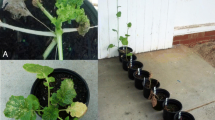Abstract
Plants of four species obtained from various sources were raised and compared for their suitability as test plants for a number of viruses. The species comprisedChenopodium amaranticolor (local lesion host of red clover mottle virus),Nicotiana glutinosa (local lesion host of tobacco mosaic virus (TMV)),N. rustica (systemic host of TMV, cucumber mosaic virus and tomato spotted wilt virus) andN. tabacum ‘White Burley’ (systemic host of TMV).
Some sources proved to be more attractive as test plants or experimental hosts because of, e.g., production of more local lesions per unit of leaf area (C. amaranticolor andN. glutinosa), distinctness of lesions (C. amaranticolor), development of more pronounced systemic symptoms (N. rustica andN. tabacum ‘White Burley’), better growth characteristics (particularlyC. amaranticolor andN. rustica), smoother leaves being easier to rub (N. glutinosa) or more and bigger leaf formation (particularlyN. rustica).
The implications for the interpretation of host range studies and the quest for propagation and assays hosts are discussed.
Similar content being viewed by others
References
Bos, L., 1967. Methods of studying plant as virus hosts. In: K. Maramorosch & H. Koprowski (Eds), Methods in virology I: 129–162.
Bos, L., Hagedorn, D. J. & Quantz, L., 1960. Suggested procedures for international identification of legume viruses. Tijdschr. PlZiekt. 66: 328–343.
Demski, J. W., 1968. Local lesion reactions of Chenopodium species of watermelon mosaic virus 2. Phytopathology 58: 1196–1197.
Frazier, N. W., 1974. Six new strawberry indicator clones evaluated for the detection and diagnosis of twelve grafttransmissible diseases. Pl. Dis. Reptr. 58: 28–31.
Fulton, J. P., 1960. Strawberry virus dissemination in Arkansas. Phytopathology 50: 477–480.
Harris, R. V. & King, M. E., 1942. Studies in strawberry diseases. V. The use ofFragaria vesca L. as an indicator of yellow-edge and crinckle. J. Pomol. 19: 227–242.
Kassanis, B. & Selman, J. W., 1947. Variations in the reaction of White Burley tobacco to the tomato aucuba mosaic virus and to some other strains of tobacco mosaic virus. J. Pomol 23: 167–170.
Köhler, E., 1953. Der Solanum demissum-Bastard ‘A6’ als Testplanze verschiedener Mosaikviren. Züchter 23: 173–176.
McRitchie, J. J. & Alexander, L. J., 1963. Host specificLycopersicon strains of tobacco mosaic virus. Phytopathology 53: 394–398.
Mosch, W. H. M., Huttinga, H. & Rast, A. Th. B., 1974. Some chemical and physical properties of 18 tobacco mosaic virus isolates from tomato. Neth. J. Pl. Path. 74: 104–111.
Author information
Authors and Affiliations
Rights and permissions
About this article
Cite this article
Van Der Want, J.P.H., Boerjan, M.L. & Peters, D. Variability of some plant species from different origins and their suitability for virus work. Netherlands Journal of Plant Pathology 81, 205–216 (1975). https://doi.org/10.1007/BF01976471
Accepted:
Issue Date:
DOI: https://doi.org/10.1007/BF01976471




